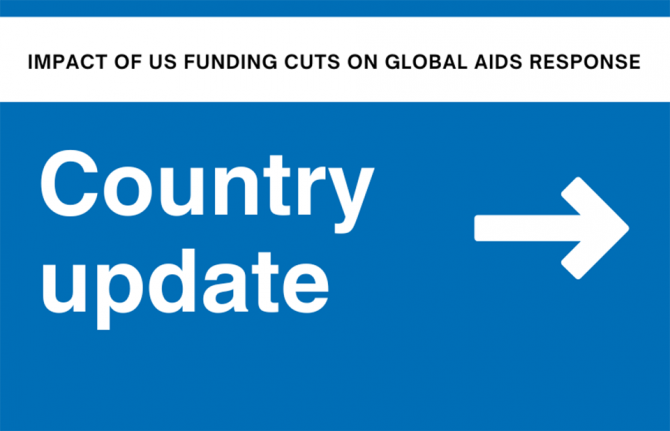

Feature Story
Impact of US funding cuts on HIV programmes in Malawi
15 avril 2025
15 avril 2025 15 avril 2025Current implementation and disruptions
• Resumption of activities: As of April 7, some CDC-funded partners, including Baylor and Partners in Hope, had resumed their activities. This involves approximately 1,771 staff supported by US funding, supporting HIV service delivery across most districts. The risk that long-acting injectable PrEP might expire has been reduced with the resumption of HIV services.
• Government facilities: Operating at reduced capacity due to gaps in specific human resources for health teams previously supported by PEPFAR, with HIV testing being most affected. The Government has allocated 23.3 billion Kwacha (US$11) million to the Ministry of Health and plans to recruit 6,000 staff covered by the 2025/26 budget to help mitigate the impact of the US funding cuts. The recruited staff will be absorbed into the Government payroll. Transportation of samples is one program area that has been impacted by the US funding cuts. The Government further allocated 3 billion Kwacha (US$1.7million) towards the transportation of HIV samples. • Essential commodities: Most essential HIV commodities, including ARVs, are procured with Global Fund resources, with current funding lasting until 2027. Condom stock levels are sufficient, but distribution, especially among young people, is affected as most NGOs who supported condom distribution have stopped providing services. Cervical cancer screening remains closed and is struggling to restart.
• Emergency areas: A recent assessment of HIV response in climate related disaster emergency prone areas highlighted gaps in the HIV response, including in HIV testing, access to services for pregnant and lactating women receiving services for prevention of vertical transmission of HIV, syphilis and hepatitis services that do not receive multi-month dispensing of ARVs (including outreach service gaps), and programmes to reduce stigma and discrimination. Because of floods, some facilities and hard to replace HIV commodities have been swept away.
Documented impact on services
• Service reductions: The country has seen the closure of centres of excellence and a drastic reduction of service provision affecting service delivery. However, as of 7 April, most CDC-funded partners had been advised to resume implementation of activities, including the NGOs conducting voluntary medical male circumcisions and programs for orphans and vulnerable children (information on which partners is yet to be confirmed).
• The US funding cuts have affected various programmes, including HIV services, supply chain management, malaria programmes, family planning, and maternal and child health services. Some of the services offered by the Government are offered at minimal capacity.
• Early infant diagnosis and paediatric HIV treatment services are affected, with all facilities working at reduced capacity.
• Testing services: HIV diagnostic assistants, supported by US funding, are no longer in service, creating gaps in HIV testing across public facilities.
• Supply chain: Stocks of antiretroviral supplies, HIV, viral load, and other lab test kits are available with minimal disruption in distribution.
• Community services: Community services are also affected, as outreach services were mostly partner-supported. Public facilities are unable to cater for the logistical costs of outreach clinics because of limited funding for fuel or not enough vehicles for transport. This is hampering access to services for hard-to-reach populations and threatens to increase default rates. In addition, 18 drop-in centres with a total cohort of 7,600 patients on antiretroviral treatment and 7,000 continuing PrEP clients are open. It is not clear if the key populations team members who were transitioned to other facilities have come back to the drop-in centres that were closed, affecting service delivery to key populations. Community-led monitoring activities have stopped, and a few are starting with support from the Global Fund, Gates Foundation and GIZ.
Human rights and key populations
• Stigma and discrimination: The US funding cuts have exacerbated stigma and discrimination faced especially by key populations members who are often blamed by the wider community for the US’ withdrawal of funding. Community members fear the cessation of antiretroviral therapy provision - and negative attitudes towards them.
• Advocacy and programming: Reduced capacity among civil society organizations to continue advocacy for domestic funding and programme design, particularly for key populations.
Politically relevant updates
• Government convening: A country-level task team, including representatives from people living with HIV and key population networks, is discussing the impact on service delivery, and identifying mitigation measures.
• National AIDS Commission: The National AIDS Commission was leading the design of development of standard operating procedures for key populations, but due to the US funding cuts, this process has halted.
UN response
UNAIDS is providing technical and financial resources to assess the HIV response during emergencies in disaster-prone districts, including the impact of the US funding cuts, to inform disaster preparedness and response intervention. The assessment was completed on April 5, 2025.
It has also developed a five-year UN Joint Programme of Support to the Government of Malawi to help highlight crucial prevention and treatment interventions the Government should prioritize to help end AIDS in Malawi.
